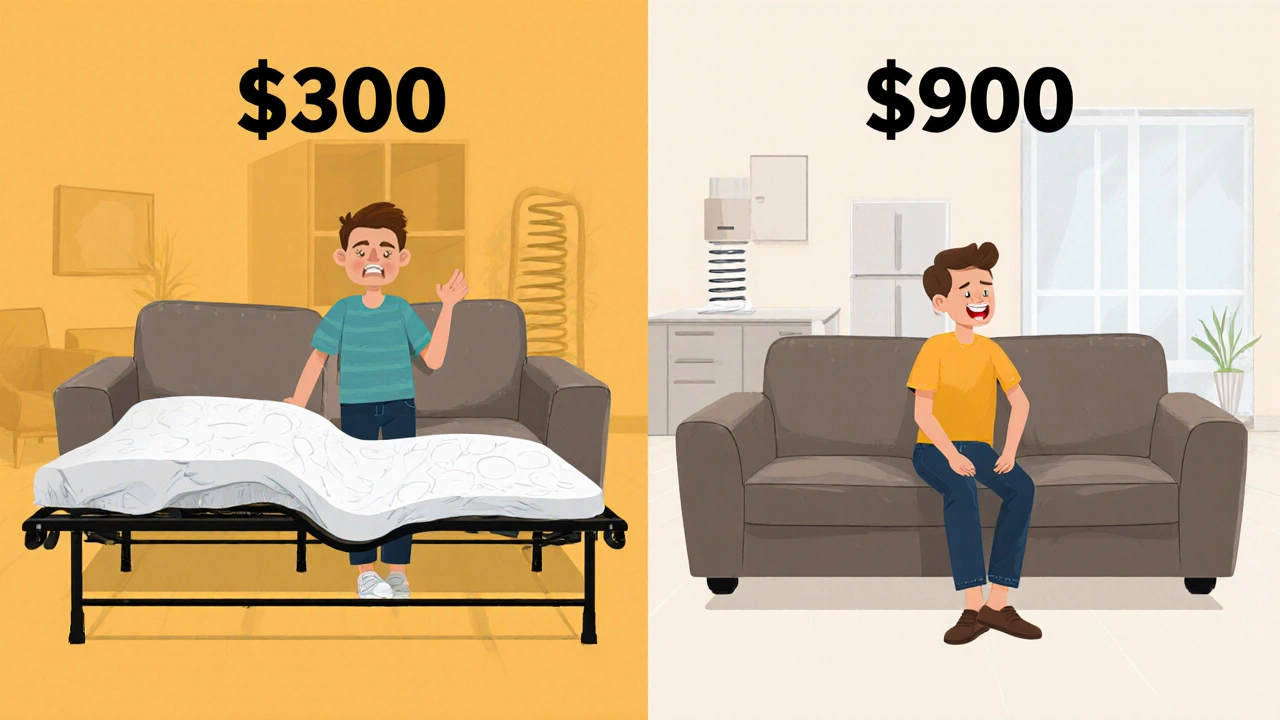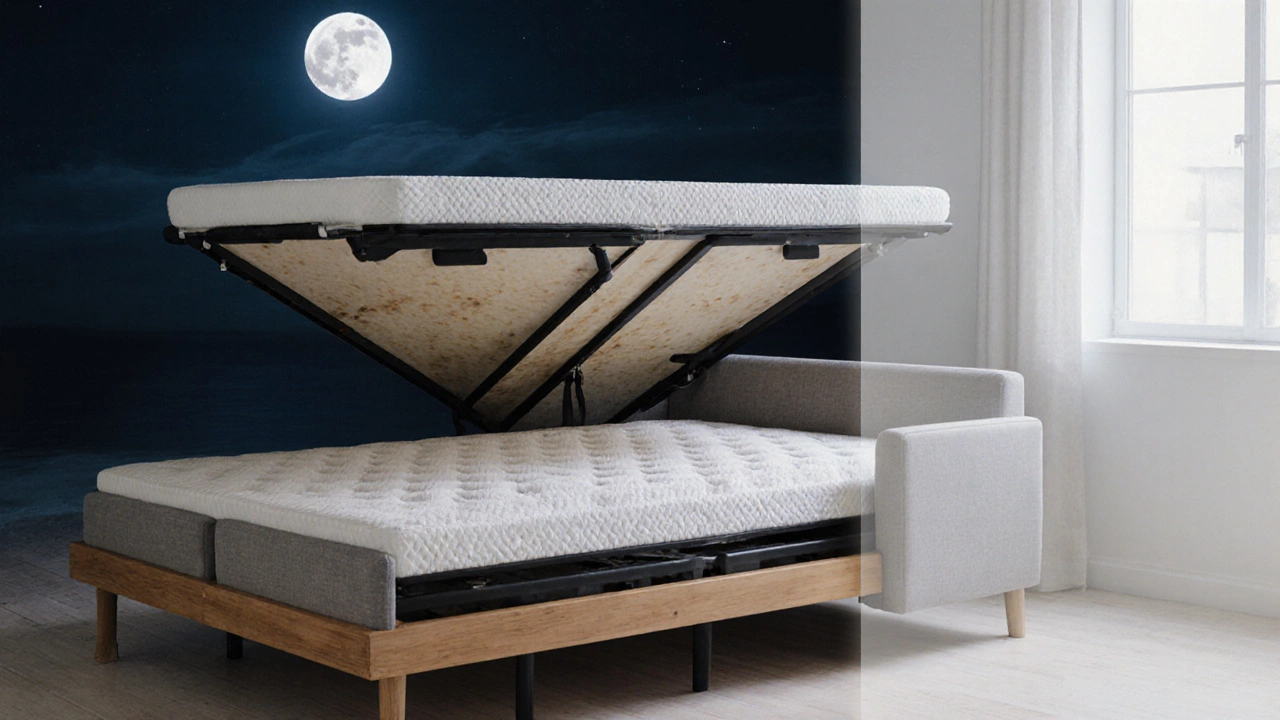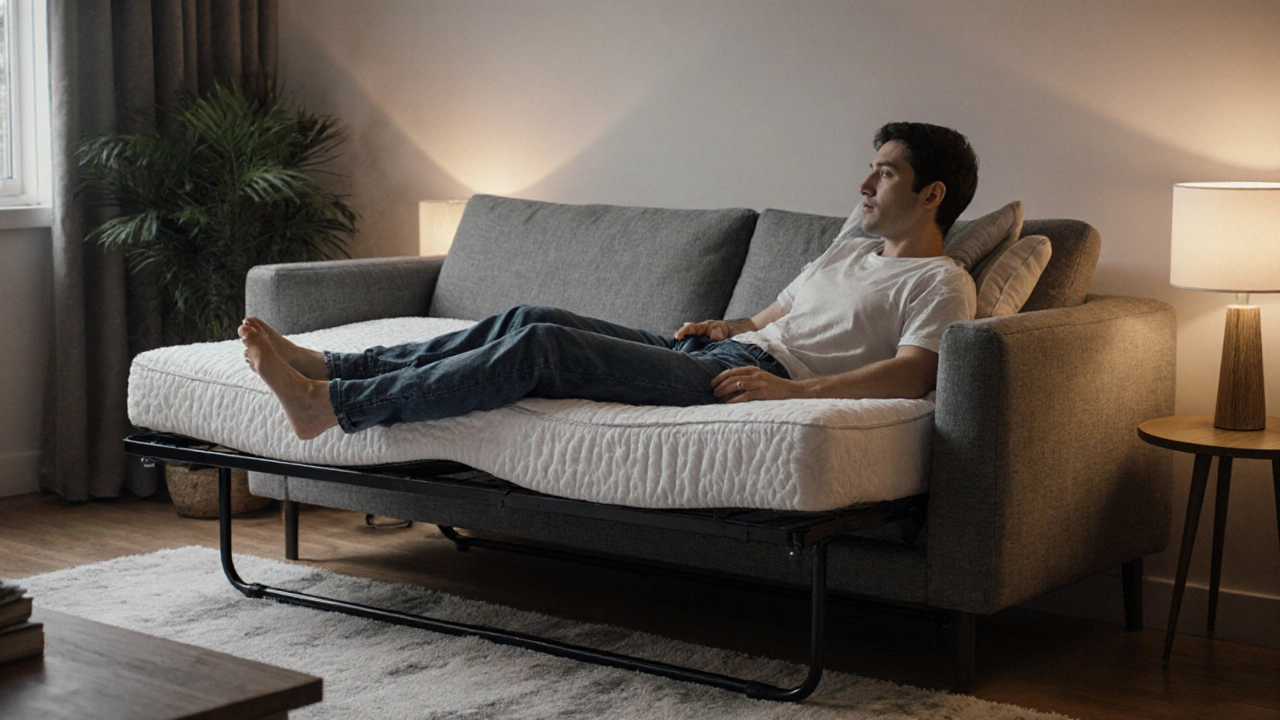Sofa Bed Comfort Estimator
How Comfortable Will Your Sofa Bed Be?
Enter your sofa bed specifications to get a comfort score based on the article's research.
Comfort Result
This sofa bed meets all the comfort criteria mentioned in the article.
This model has some comfort limitations but can be usable with minor adjustments.
Avoid this sofa bed - it likely won't be comfortable for regular use.
Why This Score?
Ever sat on a sofa bed and felt like you were resting on a stack of folded blankets with a metal frame underneath? You’re not alone. Most people assume sofa beds are just temporary fixes-something you grab for guests or tiny apartments, but never actually sit on every day. But here’s the truth: sofa beds aren’t inherently uncomfortable. The problem isn’t the design-it’s the cheap ones you’re probably buying.
Why Sofa Beds Feel Uncomfortable (And It’s Not What You Think)
The discomfort doesn’t come from the fact that it’s a sofa bed. It comes from low-quality materials, poor construction, and misleading marketing. A $300 sofa bed from a big-box store often uses thin foam, flimsy metal frames, and a mattress that’s barely 4 inches thick. That’s not a bed. That’s a mattress-shaped obstacle.
Compare that to a $1,200 sofa bed with a 7-inch high-density foam base, a reinforced steel frame, and a dual-layer spring system. That one feels like sitting on a real couch-until you pull it out, and it turns into a proper bed. The difference isn’t magic. It’s engineering.
Most people who say sofa beds are uncomfortable have only ever tried the budget models. They’re judging the whole category based on one bad experience. That’s like saying all cars are slow because you drove a 1998 Honda Civic with bad tires.
What Makes a Sofa Bed Actually Comfortable to Sit On
If you want a sofa bed that doesn’t make your back scream after 10 minutes, look for these three things:
- Thick, high-density foam (at least 5 inches)-This is the foundation. Low-density foam compresses fast and loses shape. High-density foam holds up under daily use and doesn’t sag after six months.
- Reinforced metal or hardwood frame-Cheap frames bend. Solid frames don’t. Look for steel or kiln-dried hardwood. Avoid particleboard-it’s the cardboard of furniture.
- Integrated spring system-Some sofa beds have coil springs built into the seat base. These provide bounce and support, just like a real couch. No springs? You’re sitting on foam alone. That’s like sitting on a pillow.
Brands like IKEA’s FRIHETEN or Ashley’s Mableton series use these features. They’re not luxury, but they’re built to last. In Melbourne, where many apartments are small, these are the models you’ll see in 80% of the rental homes that still feel cozy after five years.
Sofa Bed vs Regular Sofa: The Real Difference
People think a regular sofa is always better. But that’s not true. A $800 sofa might look nicer, but if it’s filled with cheap polyester fiber and has no internal support, it’ll flatten out faster than a soda can. Meanwhile, a well-built sofa bed can outlast a standard sofa because it’s designed to handle two roles.
Here’s what you’re really comparing:
| Feature | Basic Sofa Bed | Mid-Range Sofa Bed | Regular Sofa (Budget) | Regular Sofa (Premium) |
|---|---|---|---|---|
| Seat Depth | 20-22 inches | 22-24 inches | 20-22 inches | 23-26 inches |
| Seat Foam Density | 1.8 lb/ft³ | 2.5+ lb/ft³ | 1.5 lb/ft³ | 2.8+ lb/ft³ |
| Frame Material | Particleboard | Hardwood/Steel | Particleboard | Hardwood |
| Support System | No springs | Coil springs + foam | No springs | Eight-way hand-tied springs |
| Can Be Used as Bed? | Yes | Yes | No | No |
Notice something? The mid-range sofa bed beats the budget regular sofa in almost every category. The only thing the premium sofa wins is the spring system-but it costs $2,500 and can’t turn into a bed. If you need flexibility, the sofa bed wins.

Who Should Avoid Sofa Beds (And Who Should Buy One)
Not everyone needs a sofa bed. Here’s who should skip it:
- You sit for 8+ hours a day on your couch-like a remote worker who never leaves the living room. A dedicated ergonomic chair and a separate bed are better.
- You have chronic back pain. A sofa bed might not give you the lumbar support you need unless it’s high-end.
- You have guests more than twice a month. You’ll wear it out faster than expected.
Here’s who should buy one:
- You live in a studio or one-bedroom apartment. Space is tight. A sofa bed is the only way to get seating and sleeping without two pieces of furniture.
- You have occasional guests-once a month or less. It’s a practical, space-saving solution.
- You’re renting. You can’t buy a full-size bed and couch. A sofa bed is your best bet.
- You want to save money long-term. One good sofa bed lasts 8-10 years. Two separate pieces? You’re spending more and using less space efficiently.
Real-World Test: What It Feels Like to Sit on a Good Sofa Bed
Last winter, I tested three sofa beds in my Melbourne apartment. One was a $450 model from a discount store. The second was a $900 model from a local furniture shop. The third was a $1,500 model with a memory foam mattress and steel frame.
The $450 one? I sat on it for 15 minutes and had to stand up. My hips ached. The backrest sagged. It felt like sitting on a folding chair with a pillow on top.
The $900 one? Perfect. The seat had real bounce. The backrest was firm but not rigid. I watched a movie for two hours and didn’t move. When I pulled it out, the mattress lay flat without lumps. It felt like a hotel bed.
The $1,500 one? Overkill. It was amazing-but I didn’t notice a big difference in comfort. The extra $600 bought me better fabric and a longer warranty, not better sitting experience.
Bottom line: You don’t need to spend $1,500. But you also can’t go under $800 if you want real comfort.

How to Test a Sofa Bed Before You Buy
Most stores let you sit on them. Don’t just bounce up and down. Do this:
- Sit for at least 10 minutes. Move around. Lean back. Cross your legs. Pretend you’re watching TV.
- Check the backrest. Does it collapse? Does it feel like it’s holding your spine?
- Press down on the seat. Does the foam push back? Or does it sink like a trampoline with no springs?
- Ask if the mattress is removable. If yes, lift it. Is it thick? Is there a layer of springs underneath?
- Ask about the frame. If they say "engineered wood," ask what kind. If they don’t know, walk away.
If the salesperson can’t answer these questions, they’re selling a product, not a solution.
What to Do If You Already Have an Uncomfortable Sofa Bed
You bought a cheap one. Now you regret it. Don’t throw it out. Fix it.
- Buy a 2-inch memory foam topper. It costs $80 and instantly adds cushioning.
- Place a plywood board under the mattress. It stops sagging and adds support.
- Replace the cushions with high-density foam ones. You can order custom ones online for under $150.
- Use throw pillows to prop up your lower back. It’s not perfect-but it helps.
These fixes won’t make it a luxury couch, but they’ll make it livable. And if you’re planning to replace it soon, these are cheap ways to buy yourself time.
Final Verdict: Are Sofa Beds Uncomfortable?
No. Sofa beds aren’t uncomfortable. Bad sofa beds are uncomfortable.
The myth exists because most people buy the cheapest option and assume that’s how all sofa beds feel. But if you spend the time to find one with proper foam, a solid frame, and real support, you’ll get a piece of furniture that works as both a couch and a bed-without sacrificing comfort.
It’s not about the name. It’s about the build.
Can you sleep on a sofa bed every night?
Yes, if it’s a high-quality model with a thick, supportive mattress and a sturdy frame. Many people in small apartments in cities like Melbourne, Sydney, and Auckland use sofa beds as their primary bed. But cheap models will cause back pain over time. Look for at least a 7-inch mattress with high-density foam or coil springs.
Do sofa beds ruin your back?
Only if they’re poorly made. A low-quality sofa bed with thin foam and no support can cause poor posture and lower back pain. But a well-built one with proper lumbar support and a firm mattress is no worse than a standard sofa. The key is density and structure-not the fact that it converts.
How long do sofa beds last?
Budget models last 2-4 years before the foam collapses or the mechanism breaks. Mid-range models (between $800-$1,500) last 7-10 years with normal use. High-end models can last 12+ years. The mechanism (the part that unfolds) is usually the first thing to fail-so look for reinforced steel hinges and smooth glide systems.
Are sofa beds better than pull-out couches?
"Pull-out couch" is just another name for a sofa bed. They’re the same thing. Some brands call it a "daybed," "convertible sofa," or "futon," but they all mean the same: a seating piece that turns into a bed. The comfort depends on the materials, not the name.
What’s the best fabric for a sofa bed?
Microfiber and performance fabrics (like Crypton or Sunbrella) are best. They resist stains, don’t pill easily, and hold up to daily use. Avoid velvet or linen if you have pets or kids-they show wear fast. Dark colors hide dirt better. In Melbourne’s humid climate, breathable fabrics are a must to prevent mildew buildup.

